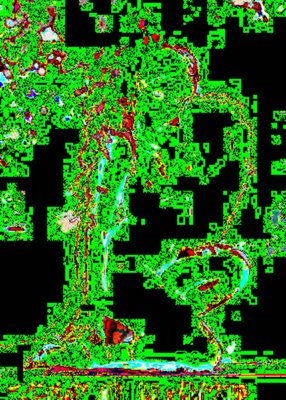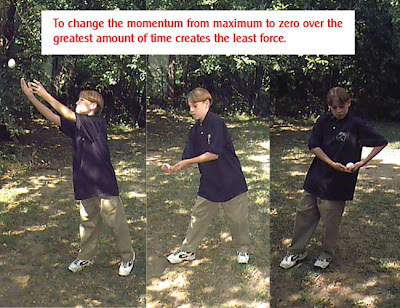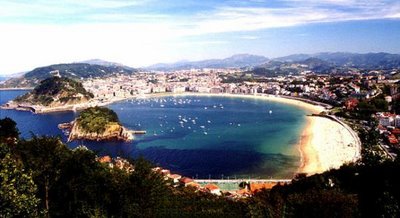Tuesday, March 20, 2007
Friday, March 16, 2007
God Doesn't Play Dice
God Does Not Play Dice, God Is Dice
Posted by
Kaz Maslanka
at
11:05 PM
2
comments
![]()
Labels: God, God doen't play dice
Tuesday, March 13, 2007
Mandelbrot Rock
Posted by
Kaz Maslanka
at
8:27 PM
0
comments
![]()
Labels: Fractals, Mandelbrot
Friday, March 09, 2007
Torque In Poetry


In response to the blog entry at Ron Silliman’s blog which pointed to this blog entry by K. Silem Mohammad: Lime-Tree (click here)
I would like to contribute to this discussion on ‘torque in poetry’ by giving an example of how one may view the mechanics of torque within a poem. Furthermore, in particular, I will give an example using the Creeley poem previously discussed.
To understand the difference between torque and linear movement in a poem we should understand the difference between the components of the two within the context of a poem. Let me reiterate the interesting ideas that Silem Mohammad has brought forward in the blog entry referenced above.
The concepts in question are pulling, pushing, syncopation, and torque. First of all pushing and pulling are generally thought to be linear forces. (in a straight line) Force can also be used in torque as in pushing or pulling something perpendicular to an axis as in the example of pushing on a swinging door. Pure rhythmic (without glissando or modulation) syncopation seems to me to be a linear force due to the idea that we generally perceive time to be linear at least in an analytical sense. I believe syncopation in music or poetry can express torque with the additional use of pitch such as a talking drum or with synaesthetic visual imagery. I believe you may experience torque in Creeley’s poem due to the visual imagery associated with physical torque as in a car swerving to miss an object in the road:
“drive, he sd, for
christ's sake, look
out where yr going.”
To imply torque in the visual structure of the poem one has to imply force moving perpendicular to an axis. Like the twisting diagram above. So this brings us to the question: What is the axis and what is the force within the structural line-breaks of Creeley’s poem?
One way to visualize the torque within the structure of his poem is to notice that the movement in the line breaks creates a curve that our vision may follow. (See diagram above) It may not follow this exact curve but it must follow a curve if you are experiencing torque. There is an argument that your eyes follow a straight line to the next line. In that case you would experience a linear force not torque.
So let’s look at a curve connecting the lines in the above diagram. The red curve is an enlargement of the black curve in our diagram. Notice that the curve varies in curvature. The radius in the curvature is changing which means the torque is changing also. However, let’s freeze our eye movement for a moment and just look at one radius which is shown in the black circle that lays on the red curve. That radius is represented for a stopped moment in time at a certain place along the curve. This is the point where we can imagine that we can see the radius of curvature that our eyes follow in this poem. This radius is the “r” value in the equation for torque.
Now we must find the force and break it down so that we can see the components of force in the poem.
One of the ways physics describes force is that “force is equal to the change in momentum of an object per the change in time during the objects spatial movement”. (F = delta mv/delta t)
The Egg Toss Game
Many of us have experienced force when playing a particular egg toss game in which the goal is to have your partner throw you an egg and you catch it without breaking it. What you are doing in this game is change the momentum of the egg from its maximum speed when it is flying toward you, to a speed of zero when you slow its fall in the palm of your hand. Furthermore, the objective is to slow its fall over the greatest amount of time possible. Force is the change of momentum per the change in time in other words if you change the momentum of the egg in a short period of time the egg breaks because you created too much force on the egg. You created much more force than if you would have caught the egg over a longer period of time.
So how does all this relate to the poem?
The force involved in at the end of the line break is equivalent to the change in the flow (momentum) in the poem per the change in time as you read it. This idea is the “F” value in the torque equation.
Since force is the change in momentum per the change in time, let’s look at what ideas comprise the momentum at the end of the line break in this poem?
Let’s go back to physics and look at the definition of momentum. Momentum is the mass of an object multiplied by the velocity that the object is traveling.
What is the mass in the poem at the end of the line break?
I see the mass being static concept in the line’s subject. For instance “the darkness” in line five of the poem is the static concept.
What is the velocity?
I see the velocity caused by anticipatory interest we have in finding what the next line says. For example the line ending in the word ‘what’ is not resolved and we experience anticipation to resolve it. Our anticipation is what is moving in our mind until the idea is resolved at the next line. The velocity then slows down as our interest slows down. In other words the more anticipation we experience then the faster our need is to resolve the idea at the next line. Furthermore, the greater the change in the momentum of our interest then the more force we experience. The more force we experience then the more torque we will experience.
Posted by
Kaz Maslanka
at
11:55 PM
2
comments
![]()
Labels: Creeley, K. Silem Mohammad, Silliman, torque in poetry
Extremism
Posted by
Kaz Maslanka
at
7:18 PM
0
comments
![]()
Labels: Christianity, Islam, KKK, similar triangles poems, Taliban
Tuesday, February 13, 2007
Marko Niemi Critical Mass
Posted by
Kaz Maslanka
at
11:24 AM
5
comments
![]()
Labels: Marko Niemi, mathematical visual poetry
Monday, February 12, 2007
Marko Niemi Divine Intervention
Posted by
Kaz Maslanka
at
2:26 PM
0
comments
![]()
Labels: Marko Niemi, mathematical visual poetry
Saturday, February 10, 2007
Marko Niemi Eye Of The Beholder
Posted by
Kaz Maslanka
at
11:13 AM
0
comments
![]()
Labels: Marko Niemi, mathematical visual poetry
Wednesday, February 07, 2007
Marko Niemi Party-NRJ
Posted by
Kaz Maslanka
at
7:31 PM
1 comments
![]()
Labels: Marko Niemi, mathematical visual poetry
Tuesday, February 06, 2007
Quote From Samuel Johnson
I am always sorry when any language is lost, because languages are the pedigrees of nations. -Samuel Johnson, lexicographer (1709-1784)
Posted by
Kaz Maslanka
at
12:51 PM
1 comments
![]()
Sunday, February 04, 2007
Delineations Between The Aesthetics Of Math And Art
I would like to invite discourse into the construction of these ideas. Everyone is invited to comment. Making these delineations is not an easy task and I feel the statements may evolve. I will address any comments to these statements.
I feel it is very important to understand the differences in the disciplines of art and math so that we can join them in the most creative, clear and meaningful ways.
Delineation #1:
Mathematical truths are discovered Artistic truths are mediated.
Delineation#2:
Mathematicians generally agree on what is mathematically correct. Artists generally have no idea what is artistically correct.
Math illuminates the supportive skeletal structure of thought whereas Art illuminates the metaphoric wind, which blows through that structure.
Science reveals the body of GGod and Art reveals GGod's mind -- or is it the converse?
Delineation#5
Pure Mathematics has no expression for poetic metaphor however; it does provide us a structure that can be used for it.
Artists have an insouciant tendency to get lost in their imagination Mathematicians have an attentive tendency to map their imagination
A mathematical theory seems to come in a flash of intuition before the final product is rigorously constructed. An artistic theory seems to come much after the artwork that has been constructed in a flash of intuition.
Delineation #10
Artistic creations are uniquely invented by individuals.
Delineation #11
Mathematics, among other things, is a language.
Art, among other things, uses language.
.
In science one tries to tell people, in such a way as to be understood by everyone, something that no one ever knew before. But in poetry, it’s the exact opposite. —Paul Dirac
.
Art is the expression of culture.
Pure mathematics is independent of culture therefore, cultureless.
Some of these were published earlier in Bridges proceedings 2002 “Sentences on the Aesthetics of Mathematics and Art” page 256
Posted by
Kaz Maslanka
at
1:41 AM
12
comments
![]()
Labels: math art moment, math is art?, mathematical art, Mathematical Poetry
Friday, February 02, 2007
Unlikely 2.0
This is my first Korean artwork
Dog Dream = Irrationality / Importance
The poem is in the form of an orthogonal space poem
Check out the lastest Unlikely Stories. My latest two pieces are among some wonderful new art/poetry work.
Posted by
Kaz Maslanka
at
10:33 AM
3
comments
![]()
Labels: Dog Dream, orthogonal space poem, unlikely 2.0
Wednesday, January 10, 2007
Temptation At The Asymptote
As you look at the graph of Y=1/x (above) you will notice the values become extremely large as you approach the asymptote where the value of x equals zero. At x = zero the y value becomes infinite (at the asymptote).
We have the same situation when we approach temptation. It gets stronger and stronger as we get closer to the object of our temptation and when you touch your temptation you lose the game. In other words the shorter the distance to your object of temptation the closer you get to the asymptote.
The form of the poem is an orthogonal space poem
Posted by
Kaz Maslanka
at
6:24 PM
5
comments
![]()
Labels: orthogonal space poem, Temptation
Sunday, January 07, 2007
Monday, December 25, 2006
Flaky Pie
Posted by
Kaz Maslanka
at
10:19 PM
5
comments
![]()
Labels: Pi
Thursday, December 21, 2006
Monday, December 18, 2006
Lothar Schmitz
 Lothar Schmitz’ sculptures reconfigure and question corporate landscape elements using man-made materials. His topiary-like treatment of landscape alludes to the accelerating pace of ecological change and genetic mutation. He draws experience from both his art and physics background. Schmitz is a past Los Angeles Cultural Affairs COLA Individual Artist Grant recipient and a physicist.
Lothar Schmitz’ sculptures reconfigure and question corporate landscape elements using man-made materials. His topiary-like treatment of landscape alludes to the accelerating pace of ecological change and genetic mutation. He draws experience from both his art and physics background. Schmitz is a past Los Angeles Cultural Affairs COLA Individual Artist Grant recipient and a physicist.
FOR IMMEDIATE RELEASE:
CONTRARY TO THE LAWS OF NATURE
Los Angeles based artists stretch those laws and present some of their own.Mitchell Friedman, Manfred Menz, Lothar Schmitz, Carrie Ungerman and Melinda Smith Altshuler address social, environmental and psychological circumstance in the landscape. Exhibition Dates: December 21, 2006 - January 27, 2007Artist’s Reception: Thursday, December 21, 5:30 pm – 7:30 pm
Sarah Lee Artworks & Projects
2525 Michigan Avenue (Bergamot Station), T1, Santa Monica, CA 90402
Media Contact: Melinda Smith Altshuler, 310 367.5246, msasees@yahoo.com
Gallery: 310 829.4938 E-mail, saralee4@verizon.net
Website: http://www.sarahleeartworks.com
Gallery hours: Tuesday through Saturday 10:30 am- 5:30 pmPlease direct e-mail inquiries about the exhibition to the gallery’s address (above);
Posted by
Kaz Maslanka
at
10:23 PM
0
comments
![]()
Sunday, November 26, 2006
Celebrate The Tenth Annual Bridges Conference
Celebrate the Tenth Annual Bridges Conference
BRIDGES DONOSTIA
Mathematics, Music, Art, Architecture, Culture
***************************************
**** http://www.bridgesmathart.org ****
***************************************
Bridges: Mathematical Connections in Art, Music, and Science
School of Architecture, The University of the Basque Country
San Sebastian (Donostia), Spain
July 24-27, 2007
The conference consists of a 4-day combination of Bridges Conference
activities (July 24, 26, and 27) and an excursion day to Bilbao (July
25). Please visit the Announcement page at the conference website for
a complete announcement.
THE CONFERENCE
The Bridges Conferences, running annually since 1998, bring together
practicing mathematicians, scientists, artists, educators, musicians,
writers, computer scientists, sculptors, dancers, weavers, model
builders in a lively atmosphere of exchange and mutual encouragement.
Important components of these conferences, in addition to formal
presentations, include hands-on workshops, gallery displays of visual
art, working sessions with artists who are crossing the
mathematics-arts boundaries, and musical/theatrical events in the
evening.
CALL FOR PAPERS
You are invited to submit either a short (two pages) or long (at most
eight pages) paper that presents new work within the scope of the
Bridges conference. Papers must be submitted as Microsoft Word or PDF
to papers@bridgesmathart.org. The deadline for paper submission is
Febrary 1, 2007. This deadline is firm! If electronic submission is
impossible, please contact Reza Sarhangi to make other arrangements.
Authors will be notified of acceptance on March 25, 2007, and final
papers will be due on April 23.
WORKSHOPS
There will be several teacher workshops for K-12 teachers and educators
at the 2007 Bridges Conference. If you are interested in making a
presentation in one of these workshops you need to submit either a
short (two page) or long (eight page) paper; The deadlines for
submissions of preliminary and final versions are the same as for the
contributed papers.
VISUAL ART EXHIBIT
At the conference, there will be an exhibition room for 2D and 3D
mathematical art, ranging from computer graphics to quilts to
geometrical sculptures. This art exhibit will be curated by Robert
Fathauer. All submitted artwork will undergo a refereeing process.
There is a limit of five submissions per artist. Images of accepted
artworks will also be published on the conference CD.
CONFERENCE REGISTRATION
There is a registration fee of US $180 that includes a copy of the
Proceedings. Extra proceedings will be available during the conference
with a price of US $50. There is a special discounted rate for
students, artists whose expenses are not otherwise supported, and K-12
teachers. Please visit the Registration page at the conference
website.
ACCOMMODATION AND FACILITIES
Participants have a choice of staying in the campus facilities
(comparable to a three star hotel and within walking distance of the
conference site) or staying in a nearby hotels (a list of hotels is
provided in the Accommodations section of the Bridges website).
MAILING LIST
You have received this message because you are subscribed to a mailing
list for Bridges-related announcements. If you would like to manage
your subscription, please visit the mailing list web page at
https://lists.uwaterloo.ca/mailman/listinfo/bridges.
Anyone interested in joining the list may send email to
bridges-join@lists.uwaterloo.ca.
OTHER INQUIRIES
For any other information not available on the web page please
contact: Reza Sarhangi, Department of Mathematics, Towson University,
8000 York Road, Towson, MD 21252, (410) 704-4922. rsarhangi@towson.edu.
Posted by
Kaz Maslanka
at
12:20 AM
1 comments
![]()
Thursday, November 16, 2006
Alligator Cubed
Presently, Dan Waber has some interesting math-poetry related images on his Blog that I would like to draw to attention. There is an interesting series of works by Mirela Roznoveanu that I would like to note, have verbogeometric properties. Although the pieces are not explicitly mathematical (they do not show equations) they do show graphic ideas in space implicitly related to a Cartesian coordinate system.
Because they are so abstract they can have numerous contexts applied to them pointing to meanings just as numerous. The resultant aesthetic experience is a vector sum of all the contexts applied. Of course this is my personal take on this and I will certainly give you room to express your own viewpoint.
 Alligator Cubed by Jeff Crouche
Alligator Cubed by Jeff CroucheThe other piece I want to point out is Jeff Crouche’s “Alligators cubed” This is a perfect example of visual mathematical poem. (a nice one at that)
Posted by
Kaz Maslanka
at
10:27 PM
0
comments
![]()





















